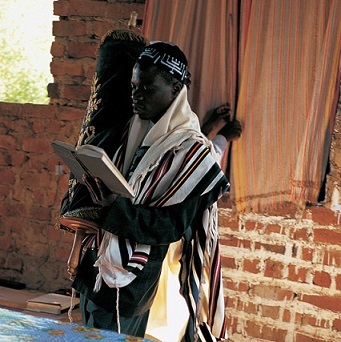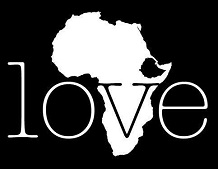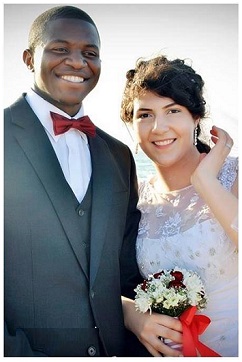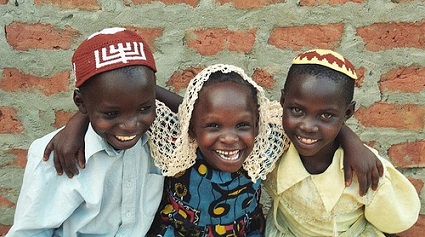One of the Lost Tribes of Israel now Found?
~ The Abayudaya Jews of eastern Uganda ~

One of the Lost Tribes of Israel now Found?
~ The Abayudaya Jews of eastern Uganda ~

Unraveling the mystery of these new-found Hebrews
Their population is estimated at approximately 2,000 having once been as large as 3,000 (prior to the persecutions of the Idi Amin regime); like their neighbors, they are subsistence farmers. Most Abayudaya are of Bagwere origin, except for those from Namutumba who are Basoga. They speak Luganda, Lusoga or Lugwere, although some have learned Hebrew as well.
When world Jewry first became aware of them (a gradual process) several interesting comparisons emerged. The Abayudaya attend Shabbat services regularly both on Friday evenings and Saturdays. Congregations remove their shoes before entering the synagogue. This custom is believed to have been practiced by Jews in biblical times and is still practiced by a few Jewish communities today. The Abayudaya maintain a Kosher diet and slaughter their own animals in accordance with its regulations.
According to rabbinic literature, the Ten Lost Tribes of Israel were exiled beyond the River Sambation -- whereabouts not really known. The first mention is in the Targum Yonatan on Exodus. It has been argued that River Sambation was the Atlantic Ocean, and the ten lost tribes were native Americans. But new evidence points in a different direction -- to Africa. To many people, the following may seem to be politically incorrect revisionism.
Do you realize, throughout scripture Israel is described as looking like the sons of Ham in physical appearance?
If you recall, Ham was one of Noah's three sons, Shem and Japheth were the other two. Noah's descendants repopulated the earth after the Great Flood. Ham's descendants are traced to the families of Africa. Ham in Hebrew means black, hot, and burnt.
Indeed, According to Alice C. Linsley
The Bible has been used, quite wrongly, to support [white] racism throughout history. One such text is the "curse of Ham" in Genesis, a gloss that comes from the rabbis. This gloss is not consistent with the older tradition, as is evident in analysis of the kinship pattern of Abraham's Horite people. For example, the men listed in Genesis 4 and 5 are rulers whose lines intermarried exclusively. The same is true for the lines of Ham and Shem, Noah's sons. This means that Abraham was a descendant of both Ham and Shem.
Ham had four sons
The Israelites are descendants of Noah son SHEM, through Abraham, he is the father of the Hebrew Israelite Nation. Abraham is the father of Isaac, Isaac is the father of Jacob, Jacob had twelve sons and these sons are the progenitors of the Israelite nation.
Now, throughout the book of Genesis, we find that Israel had reccurring intercourse on both sides of the Red Sea. That is, the continent of Africa. Abraham spent time there. Enoch was an Ethiopian. The Patriarchal period gives a glimpse of Hebrew people in constant commerce with Africa, the land of Ham. But what about the Exodus from Egypt. "Out of Africa have I called my son."
Gerald Massey, English writer and author of the book, Egypt the Light of the World, wrote, "The dignity is so ancient that the insignia of the Pharaoh evidently belonged to the time when Egyptians wore nothing but the girdle of the Negro." (p 251)
Sir Richard Francis Burton, a 19th century English explorer, writer and linguist in 1883 wrote to Gerald Massey, "You are quite right about the "AFRICAN" origin of the Egyptians. I have 100 human skulls to prove it."
Scientist, R. T. Prittchett, states in his book The Natural History of Man, "In their complex and many of the complexions and in physical peculiarities the Egyptians were an "AFRICAN" race (p 124-125).
The Ancient Greek historian Herodotus, who visited Egypt in the 5th century B.C.E., saw the Egyptians face to face and described them as black-skinned with woolly hair.
Anthropologist, Count Constatin de Volney (1727-1820),spoke about the race of the Egyptians that produced the Pharaohs. He later paid tribute to Herodotus' discovery when he said:
The ancient Egyptians were true Negroes of the same type as all native born Africans. That being so, we can see how their blood mixed for several centuries with that of the Romans and Greeks, must have lost the intensity of it's original color, while retaining none the less the imprint of it's original mold. We can even state as a general principle that the face (referring to The Sphinx) is a kind of monument able, in many cases, to attest to or shed light on historical evidence on the origins of the people."
The fact that the ancient Egyptians were black-skin prompted Volney to make the following statement:
"What a subject for meditation, just think that the race of black men today our slaves and the object of our scorn, is the very race to which we owe our arts, science and even the use of our speech."
The testimony of the ancients, the scriptures, & many Egyptologists, along with archaeology confirms that the Egyptians during biblical times were a "BLACK" people. This is important to know, as we continue, we'll see that the bible on multiple occasions describes the ancient Hebrews as looking like the Egyptians in physical appearance.
George Rawlinson, an English author wrote a book entitled History of Egypt. On page 252, he gives a description of Seti I, the Pharoah of the Exodus. He states: "Seti's face was thoroughly African (Negroid, sub-Saharan). He had a stormy face with a depressed flat nose, thick lips and heavy chin."
Almost a
Resurrection From the Dead, as it were
This led to conflict with the British when the Bamalaki refused to vaccinate their cattle. However, upon further study of the Bible, Kakungulu came to believe that the customs and laws described in the first 5 books of Moses (Torah) were really true. When, in 1919, Kakungulu insisted on circumcision as is prescribed in the Old Testament,the Bamalaki refused and told him that, if he practiced circumcision, he would be like the Jews. Kakungulu responded, "Then, I am a Jew!" He circumcised his sons and himself and declared that his community was Jewish. According to Henry Lubega "he fled to the foot of Mt. Elgon and settled in a place called Gangama where he started a separatist sect known as Kibina Kya Bayudaya Absesiga Katonda (the Community of Jews who trust in the Lord)." The British were infuriated by this action and they effectively severed all ties with him and his followers.
The mysterious 'Yosef'
Furthermore, the laws concerning Kashrut were first introduced to the community by this Yosef. The community continues to practice kashrut today. Yosef's teachings influenced Semei Kakungulu to establish a school that acted as a type of Yeshiva, with the purpose of passing on and teaching the skills and knowledge first obtained from Yosef.
After Kakungulu's death from tetanus in 1928, Samson Mugombe Israeli, one of his disciples, became the spiritual leader of the community. They isolated themselves for self-protection and survived persecution, including that of Idi Amin, who outlawed Jewish rituals and destroyed synagogues. During the persecutions of Idi Amin, some of the Abayudaya community converted to either Christianity or Islam in the face of religious persecution. A core group of roughly 300 members remained, however, committed to Judaism, worshiping secretly, fearful that they would be discovered by their neighbors and reported to the authorities. This group named itself "She'erit Yisrael" -- the Remnant of Israel -- meaning the surviving Ugandan Jews.
The coming of the Israeli Arye Oded
"Approximately 400 Abayudaya community members were formally converted by five rabbis of the Conservative branch of Judaism in February 2002", and conversions by conservative rabbis continued during the following years.
As of 2009, most of the community lives around the Moses synagogue on Nabugoye Hill outside Mbale or the nearby synagogue in the village of Namanyoyi. Others live several miles away from Mbale in Nasenyi and Putti (both in Pallisa District). A fifth synagogue is in Magada village (Namutumba District), approximately 70 km distant.
Currently the She'erit Yisrael community is looking for help in its desire to undergo an orthodox giur (conversion to Judaism) and make aliyah (move to Israel). This community is centered around the Putti synagogue and consists of roughly 130 members.
Gershom Sizomu
An interesting recent development occurred in 2012 with the possible recognition of the Putti Abuyadayas by Israel and the Othodox Jewish world, thanks to the efforts of Rabbi Shlomo Riskin, founding Chief Rabbi of Efrat and Chancellor of Ohr Torah institutions and Rabbi Aaron Malinsky from the Jewish community of Antwerp, Belgium and also thanks to the new local leaders Enosh Keki Mainah and Adam Hirschfield. A new synagogue and a new mikva (ritual bath) has been built.
Their Christian and Muslim neighbors once looked upon the Abayudaya with disdain and hatred, but relations have improved significantly and some view members of the Abayudaya with respect and admiration. It should also be noted that the community has been growing at a steady rate. The devastating persecutions of Idi Amin decimated the population, so the current exponential growth is nothing short of a "miracle."
thanks Wikipedia, the free encyclopedia
The Abayudaya are a community of Baganda Jews who live in eastern Uganda near the town of Mbale. The word Abayudaya is Luganda for "People of Judah", roughly meaning Children of Israel. While European Jews have been reluctant to embrace them as true Jews, a change seems to be occurring. One thing is certain : they are devout in their practice of the ancient Jewish religion, keeping their version of kashrut, and observing Shabbat. There are several different villages where the Ugandan Jews live. Most of these are recognized by the Reform and Conservative movements of Judaism. However, the villagers of Putti are still seeking an Orthodox conversion and practice strict Rabbinical Judaism.
The Ancient Biblical Legend
Let me offer some information that has come to light.
Gathering the Dry Bones
All four of Ham's sons and their descendants settled in and around the continent of Africa, this includes the so called Middle East which is also a part of the Continent of Africa. Ham sons are the people of the African continent, the Ancient Egyptians, Ethiopians, Somalia's, Canaanites etc.
The following facts I offer for your consideration (from hebrew-israel)

Modern Times
In modern times, Uganda's sect of Abayudaya Jews owes its resurrection to Muganda military leader Semei Kakungulu. Originally, Kakungulu was converted to Christianity by British missionaries around 1880. He believed that the British would allow him to be king of the territories, Bukedi and Bugisu, that he had conquered in battle for them. However, when the British limited his territory to a significantly smaller size and refused to recognize him as king as they had promised, Kakungulu began to distance himself from them. In 1913, he became a member of the Bamalaki sect following a belief system that combined elements of Christianity, Judaism and, most notably, a refusal to use western medicine (based on a few sentences taken from the Old Testament).
The arrival of a foreign Jew known as "Yosef" in 1920 whose ancestral roots are believed to have been European, contributed much towards the community's acquisition of knowledge about the seasons in which Jewish Festivals such as Pesach, Shavuot, Rosh Hashanah, Yom Kippur, Succot, and others take place. A source in the Abayudaya community confirms that the first Jew to visit the community was Yosef, who stayed with and taught the community for about six months, and would appear to have first brought the Jewish calendar to the Abayudaya community.
In 1962, Arye Oded, an Israeli studying at Makerere University, visited the Abayudaya and met Samson Mugombe. This was the first time the Abayudaya had ever met an Israeli and the first Jew they had met since Yosef. Oded had many long interviews with Mugombe and other leaders and explained to them how Jews in Israel practised Judaism. Oded then wrote a book ("Religion and Politics in Uganda,") and numerous articles on the community and their customs which introduced them to world Jewry. The community underwent a revival in the 1980s.
Gershom Sizomu, the spiritual leader of the Abayudaya and the Rosh Yeshiva, was enrolled in the Ziegler School of Rabbinic Studies a five-year graduate program at the American Jewish University (formerly the University of Judaism) in Los Angeles, California where he studied Hebrew, rabbinic literature, the Bible, Jewish philosophy, and other subjects. The program entailed studies in both the USA and Israel. Upon completion of this program, Sizomu received his ordination as a rabbi under the auspices of the Conservative Movement on May 19, 2008, and returned to Uganda to lead its Jewish community.

Rodrigues Kuyanda Israel & Diana Creteanu Israel
Mazel Tov - Luanda
See reluctant messenger Enoch
See the Dance theatre of Beta-Israel
See ancient Beta Israel Ethiopia's Jews
Black American Jews "Black and Jewish"
Beit Avraham The Kechene Jews of Ethiopia
Operation Solomon daring rescue of Ethiopian Jews
Ancient enduring Ethiopia this noble land forgot by time
Prophetic Ethiopia God-fearing hanifs since the time of Enoch
Beta 'Esra'el (Falasha Jews) ye-Ityoppya Ayhudi (Jews of Ethiopia)
Somalia's Yibir (Yahhar) Are these primitive Hebrews lost Jews?
The lost Abayudaya Jews of east Uganda, near Mbale town beneath Mt Elgon
The Rusape Jews of Zimbabwe the 'lost' Jewish Rusape community discovered
Falasha Black Jews Of Ethiopia Mark Wells "Knowledge is King" - Amos 9:7
Yosef A.A. Ben-Jochannan African Origins of the Major Western Religions
Africa's River Nile source of holy scripture and the great biblical faiths
Family Values are thoroughly Hebraic Judaism's philoprogenitivity
Awash in a sea of faith uncovering revivalist gospelism
The Africans Who Wrote the Bible
Hebraic African roots of Judaism -- and Christianity & Islam, too?
Out of Egypt I called my Son - Shemitic-Hamitic-Cushitic roots (eastern Africa and civilizations of the Nile)
The Patriarch Enoch - known as 'the Ethiopian' : greater than Abraham, holier than Moses
Moses in Africa - "learned in all the wisdom of the Egyptians, mighty in words and in deeds"
Hosarsiph, the black prince of Egypt - by rabbinic legend, onetime King of Ethiopia
The clue to messianic thaumaturgy in the gospels - ancient African writings hold a key
Runoko Rashidi : ancient Egypt, primordial Africa - seeking Mother Africa
European Jewry forced to rethink the black LEMBA Jews - of Zimbabwe region
Awash in a sea of faith - the grass-roots pervasiveness of American revivalist gospelism
Jewish lore: Moses as King of Ethiopia - Freud believed Moses was Ethiopian
Ethiopia's Jerusalem Model - the Lalibela mystery, Ark of the Covenant
Ploughing sand : British rule in Palestine - Naomi Shepherd
My Ethiopian Boy : Ofra Haza sings the movie "Live and Become" (you.tube)
On wings of eagles - mobilizing to help Ethiopia's forgotten Jews
Outside mainstream doctrine - the secrets of ancient scripture
Keepers of the Lost Ark - beyond Indiana Jones (to Axum)
Cheikh Anta Diop - called our Pharoah of Knowledge
Spiritual Treasures of Africa - antiquity's bequest
